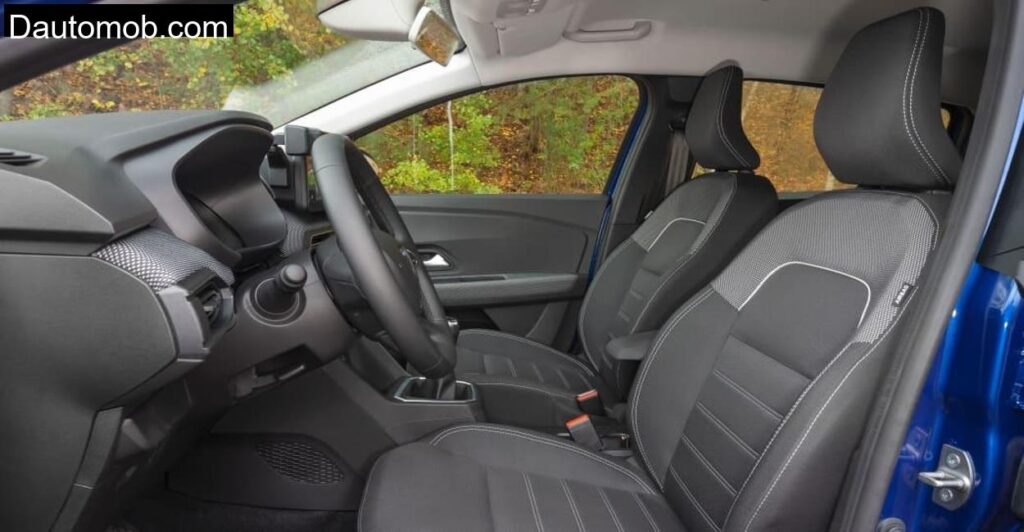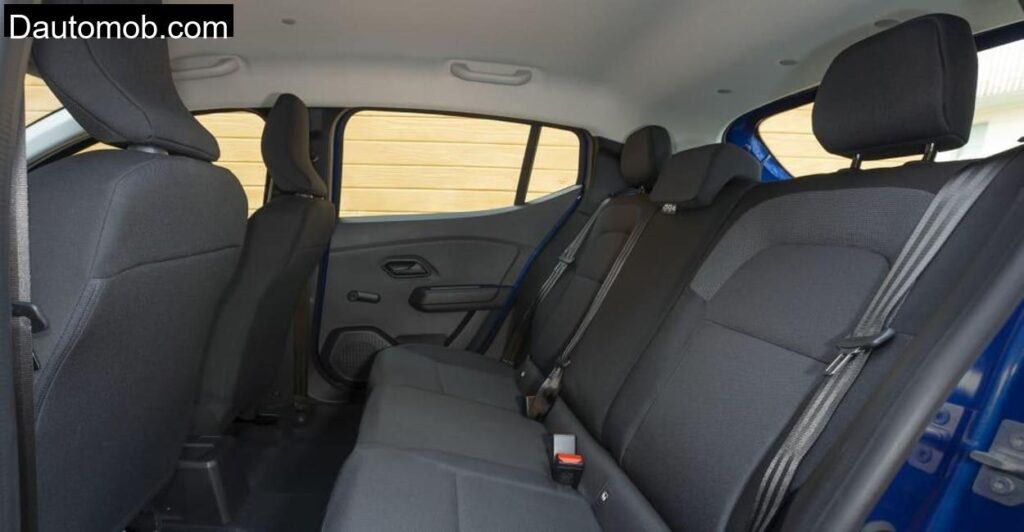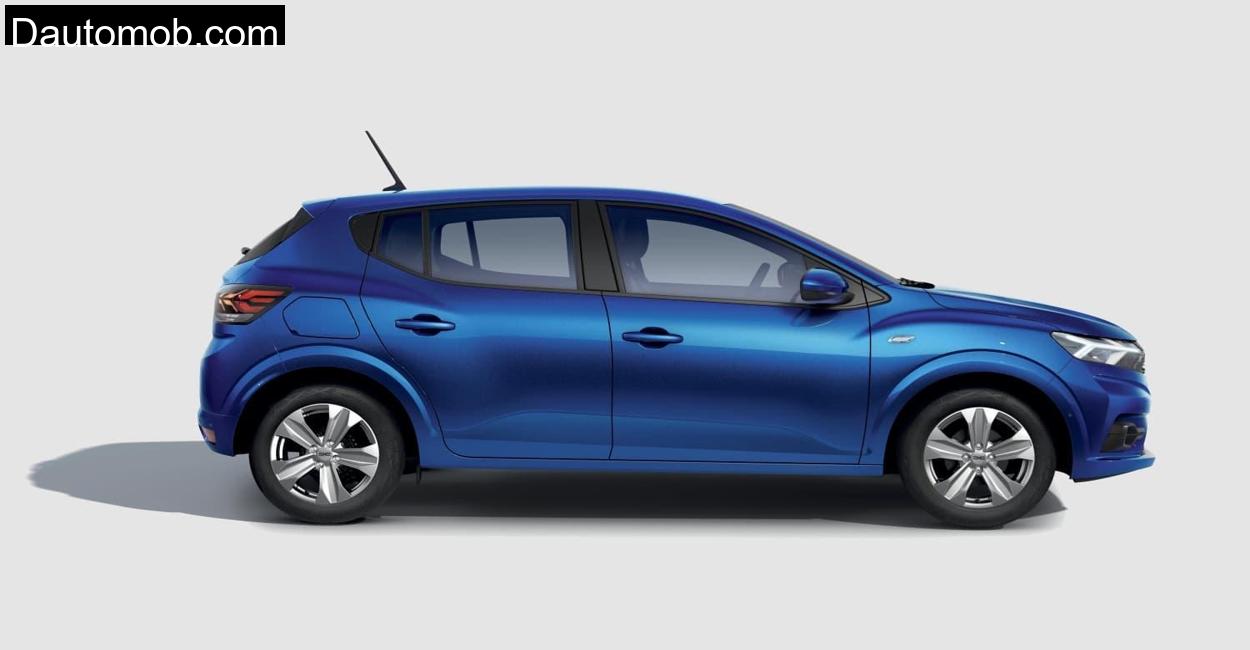A New Face for a New Generation
The Dacia Sandero has grown up. At 4.09 meters long and nearly 1.85 meters wide, the current model doesn’t just outstretch rivals like the VW Polo and Opel Corsa, it also stands more confidently on the road. Gone is the awkward, budget, box vibe. What you get instead is a clean, bold front end framed by Y, shaped LED headlights and a grille that finally says, “yes, I belong in 2025.”
Driving through the narrow stretches of forest trail near Weißwasser, the Stepway’s extra ground clearance, four centimeters more than the standard Sandero, made easy work of small dips and loose sand. There’s no AWD here, but unless you plan to off, road with intent, you won’t miss it.
Living Inside the Sandero , It’s Not 2005 Anymore

Inside, the biggest surprise wasn’t what Dacia added, it’s what it got right. Gone are the hollow plastics and utilitarian layouts of the older generations. In our Expression model, cloth accents ran across the dashboard, and the overall finish felt more mature, even stylish in places. Sure, it’s still a budget car, but now it feels intentionally simple, not cheap.
The touchscreen infotainment system in the Expression trim is an 8, inch unit with Android Auto and Apple CarPlay support. It worked flawlessly during our drive, and having proper smartphone integration makes a world of difference. In lower trims, Dacia offers an honest solution: a smartphone dock that turns your device into the infotainment system. Smart, simple, and cost, cutting, but not cutting corners.
Rear seat space is surprisingly usable. I’m 1.83 meters tall and had enough legroom sitting behind my own driving position. Three across would be tight, but two adults are perfectly fine. The trunk, at 328 liters, held our gear and camera bags with ease, and with the seats down, there’s over 1,100 liters of space, plenty for even a camping weekend if you pack smart.
Driving the Sandero , Lively Where It Counts

We tested both the standard Sandero TCe 90 Expression and the Sandero Stepway TCe 90 Essential, both powered by the same 1.0, liter turbocharged three, cylinder petrol engine. It makes 91 hp and 160 Nm of torque, and it weighs just a bit over 1.1 tons, so don’t scoff at the numbers. In the real world, it pulls cleanly, especially between 2,000 and 4,500 rpm.
On open stretches through Muskau Heath, I found the five, speed manual gearbox a surprisingly good companion. Gears are long, especially in fifth, but they help keep fuel consumption in check. On paper, it hits 0, 100 km/h in 11.7 seconds. In practice, you rarely need that kind of sprint. What matters more is the midrange punch, and that’s where the Sandero impressed me.
The steering is light and leans on the vague side, but it never feels unsafe. You wouldn’t carve mountain passes with it, but it’s not trying to be a hot hatch. On the loose gravel and dusty back roads through the heath, it stayed composed, even when pushed a little harder than polite society would approve of.
Ride comfort was another win. Even over the rippled tarmac of a logging road, the suspension filtered out chatter impressively. There’s a slight tendency to bounce over sharper bumps, especially in the Stepway with its raised suspension, but nothing that disrupted control. On the highway, it was stable, quiet for its class, and cruised happily at 130 km/h with the engine ticking over at just under 3,000 rpm.
Fuel Efficiency and Real, World Use
Over our combined route, about 180 kilometers of city, rural, and mild off, road terrain, the Sandero returned an average of 5.8 liters per 100 km. That’s not just respectable, it’s frugal. The Stepway, which carries a bit more weight and rides a bit taller, returned 6.3 liters. These match closely with Dacia’s official WLTP figures, which is rare.
And emissions? The days of the dirty Dacia are over. Both variants meet current Euro 6d standards, and real driving emissions (RDE) testing confirmed low particulate levels. Clean, efficient, and simple. It’s everything a small combustion engine should be in 2025.
Equipment , No Longer Spartan
In terms of equipment, the Sandero has stepped up. Even the base models get emergency braking, power steering, electric front windows, and LED headlights that shine 110 meters down the road. Step up to Expression, and you add cruise control, touchscreen infotainment, USB ports, and better sound insulation.
Optional extras like heated seats, blind spot monitoring, and electric parking brake are available, but they don’t drive the price into oblivion. It’s a rare thing, a car where the mid, trim feels like enough, and ticking boxes doesn’t punish your wallet.
Verdict: More Than Just the Cheapest Car in Germany
By the time we rolled back into the gravel lot on the edge of Muskau Heath, the Sandero had earned my respect. It’s not flashy, it won’t win any stoplight drag races, and no one will turn their heads at the supermarket. But it gets the job done, comfortably, quietly, and without draining your bank account or disappointing you behind the wheel.
Dacia hasn’t just improved the Sandero, they’ve redefined what it means to buy a “budget” car. It’s no longer the cheapest new car in Germany because it’s stripped to the bone. It’s the cheapest despite offering the things that most people actually need: decent space, modern tech, low running costs, and a surprisingly enjoyable drive.
Is the Dacia Sandero underpowered?
Not at all. The 91 hp engine pulls well thanks to its low weight and smart gearing. It’s not a hot hatch, but for daily driving, including highway work, it’s more than adequate.
What’s the difference between the Dacia Sandero and Stepway?
The Stepway adds SUV styling, slightly more ground clearance, and a six, speed gearbox. Mechanically, it’s very similar but looks more rugged and is better suited for mild off, roading.
